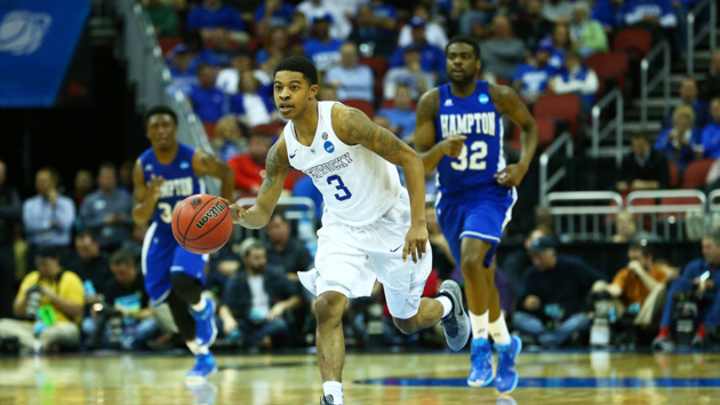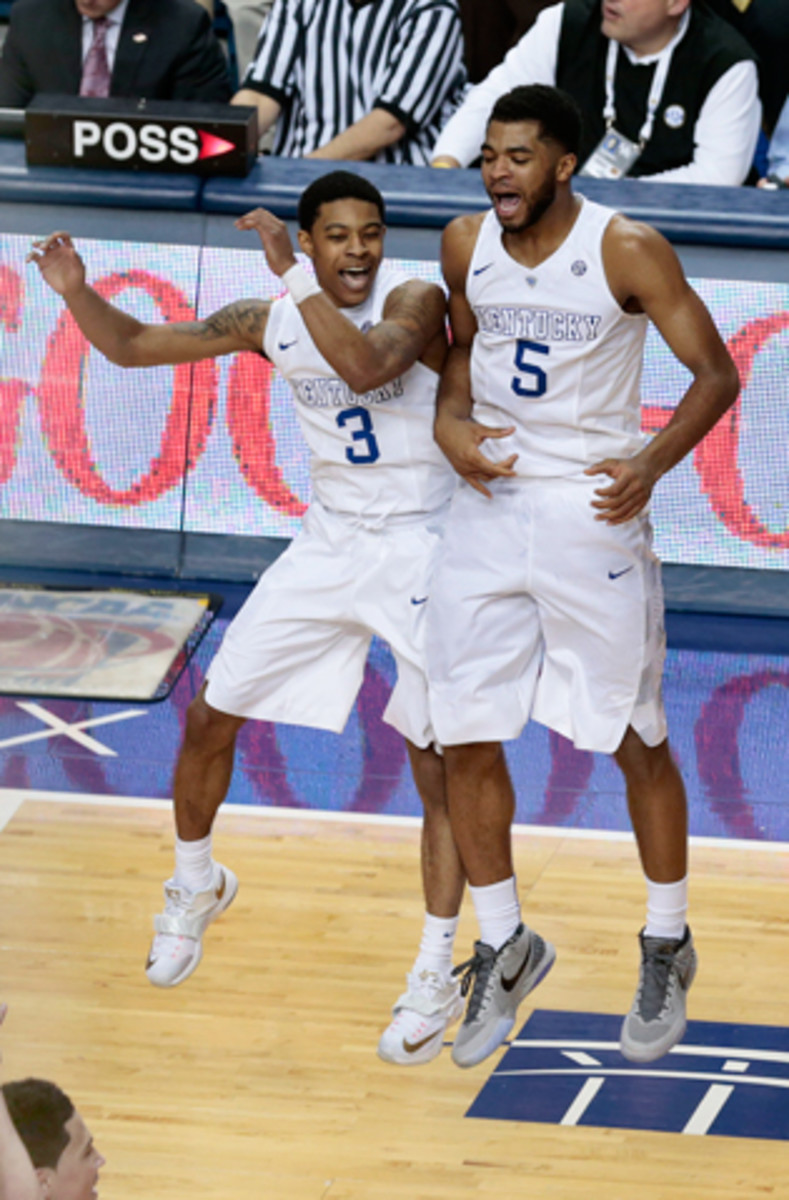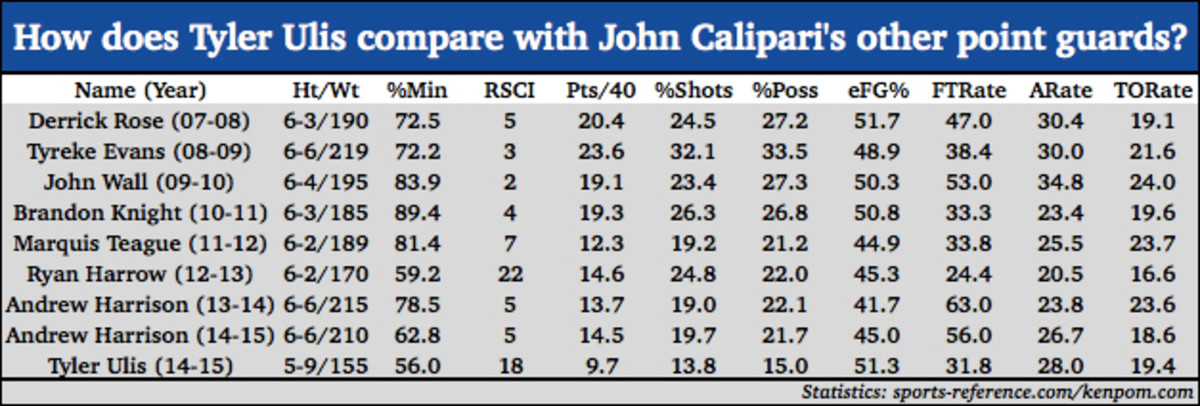Tyler The Creator: How Kentucky's Ulis is unique among Calipari guards

LOUISVILLE, Ky.—Near the end of Kentucky’s latest blowout win last Saturday, Cincinnati forward Jermaine Sanders put Tyler Ulis in his place.
On a fastbreak, Ulis fired a pass to Aaron Harrison, who gave it back to him near the restricted area. Ulis pump-faked as a defender flew by and lofted the ball toward the rim. Sanders, who had hustled back to defend, swatted the shot out of bounds. His attempt a complete failure, Ulis smiled.
That sequence didn’t affect the outcome of the game. At the time, Kentucky led by double digits and would cruise to a 13-point win to earn a spot in the Sweet 16 against West Virginia on Thursday night. Nor did it really detract from Ulis’s performance, which included five assists, nine points and three steals in 34 minutes. But it was the latest example of a moment in which Ulis looked like he didn’t belong.
Of course, that’s far from true. Even though he’s listed 5’9’’, 155 pounds, Ulis has served as a significant contributor on a team that, depending on the conclusion of its season, likely will be remembered as one of the best in college basketball history. Yet his physical dimensions stand in stark contrast to those of some of his teammates, including seven who measure at least 6’8.’’
• MORE CBB: What to watch for in Thursday's Sweet 16 games
While those who have watched Ulis play this season can appreciate what he brings to Kentucky, his stature may lead some to wonder how he ended up with the Wildcats—a program that, since coach John Calipari took over in 2009, has become synonymous with recruiting the biggest, most explosive athletes in the country and developing them for one season before they leave for the NBA.
*****

When Ulis arrived at Marian Catholic High, a private school located in Chicago Heights, Ill., in 2010 he stood around 5’3’’ and weighed between 115-120 pounds. Despite his size, Ulis proved that he belonged on the varsity squad and became a starter as a freshman. Yet coaches from big college programs didn’t begin intently recruiting him until some time later. For Ulis to be considered as one of the top point guards in the country, he had to prove that he could overcome his physical limitations.
He began that work as a middle-schooler in Lima, Ohio, where he lived with his mother. Travis Walton, a former Michigan State star, ran drills with Ulis and played him one-on-one. Walton, who now serves as an assistant coach for the Idaho Stampede of the NBA D-League, said what distinguished Ulis from an early age was his high basketball IQ. “He could shoot, he could dribble, but what he did very well was—he understood the game,” Walton says.
That trait helped Ulis shine at a camp as a grammar-schooler even though he was playing with kids three years older than him. According to Ulis’s father, James, Ulis had been placed in a group that would require him to use lowered baskets, but he cried to his father, who consulted with the leader of the camp to allow Ulis to move up to a group using 10-foot rims. James said Tyler was named the Most Valuable Player and won the hustle award.
In 2010, then 5’4”, Ulis played at the Buckeye Prep Elite Showcase, and a mixtape of his exploits that has since been viewed nearly 82,000 times was uploaded to YouTube.
Ulis moved from Lima to the Chicago area with his father before his freshman year of high school. At a star-studded youth camp that summer, James Ulis said local high school coaches unfamiliar with Ulis inquired about which school he planned to attend. When Marian Catholic’s coach, Mike Taylor, watched Tyler for the first time at an exhibition game that summer, he was immediately impressed with how advanced his skills were.
Before Ulis blossomed into a national recruit, however, he needed to make strides off the court. Early in his high school career, Ulis would train with his dad at Marian Catholic or a rec center near their home. During his sophomore year, Ulis began working with Eric Nawracaj, the president of Roc Solid Sports. Nawracaj put Ulis through strength and conditioning and basketball-specific workouts as often as four times per week.
The more stringent training regimen coincided with a growth spurt. Between the end of his freshman year and the middle of his sophomore year, Ulis grew five or six inches. By that point, he was already drawing interest from several mid-majors, but one game sent his recruiting profile skyward. In July 2013, Ulis scored 22 points and dished out 17 assists in against Duke’s Tyus Jones, considered one of the top players in the class of 2014, at the Nike Peach Jam in North Augusta, S.C.
Midwest region reset: In Cleveland, Kentucky still the team to beat
James Ulis said that soon after that game he received a call from Calipari, and the Wildcats ramped up their pursuit of Tyler. In August, Ulis narrowed his list to four schools: Iowa, Kentucky, Michigan State and USC. Kentucky extended Ulis a scholarship offer during an unofficial visit later that month, and he committed to the Wildcats in September. Ulis said his decision was motivated, in part, by Calipari’s history of developing guards into pro prospects.
“He was honest with me coming here,” Ulis says of Calipari. “This is a big stage. He told me that I was going to have to be the best player I could be coming here. And you know, it’s just competition every day.
The Wildcats had been recruiting other, more heralded point guards in the same class, including Jones and Emmanuel Mudiay, who was considered their top target at the position. Jones later chose Duke as part of a package deal with Jahlil Okafor, and Mudiay committed to SMU in August. (He later chose to play professionally in China.) At a news conference in December, Calipari was asked if it’s safe to assume Ulis probably would not be at Kentucky had the program earned a commitment from Mudiay.
“If he didn’t want to come,” Calipari said. At that same news conference, Calipari said he “didn’t have to beg” Ulis, that he recruited Ulis for three weeks and that he had told Ulis, “I'm hearing about you being a four-year point guard. If you think you're here four years, don't come here.” According to Calipari, Ulis responded by saying, “I’m coming.”
Ulis was named a McDonald’s All-American and finished his senior year ranked 18th in the RSCI, a composite recruiting measure incorporating several services. Although guards Andrew and Aaron Harrison decided to spend their sophomore seasons at Kentucky rather than declare for the NBA draft, Ulis has carved out a significant role. He provided evidence that he belonged during Kentucky’s six-game preseason trip to the Bahamas by averaging 7.7 points, four assists and holding his own on the defensive end.

Calipari said before the season that he planned to use a platoon system through which the Wildcats would rotate five-man units. Ulis joined freshman guard Devin Booker, freshman forward Trey Lyles, sophomore forward Marcus Lee and sophomore center Dakari Johnson on the White platoon, which outscored the Blue platoon by 0.3 points per possession over the first 10 games of the season, according to statistics GroupStats provided to Sports Illustrated’s Luke Winn.
At Louisville, in a game considered the biggest obstacle to an undefeated regular season, Ulis shined by scoring 14 points and committing zero turnovers. Andrew Harrison had six turnovers and shot 1-of-6 in six fewer minutes than Ulis, and video surfaced of Calipari berating Harrison during a huddle. Afterward, Calipari tried to defuse controversy. “So what I have is I have two terrific point guards, who I can play together if I choose,” Calipari said. “If Andrew's playing really well Tyler will maybe not play as much or I'll put him as a wing. Tyler's playing well or out of his mind. That's what good about this.”
Calipari has abandoned the platoon system but still rotates nine players and boasts one of the deepest rosters in the country. According to kenpom.com, Harrison has played 62.8% of available minutes and Ulis has played 56.0%. Teammates say the dynamic of having both on the court at the same time has improved over the course of the season. “We’ve gotten used to it, they’ve gotten used to it,” Lyles says. “So, you know, it’s working out positively for both of them now.”
While it’s tempting to compare Ulis and Harrison because they play for the same team, the former offers a different skill set than the point guards Calipari has coached dating to his tenure in Memphis. The chart below shows the primary point guard on every Calipari-coached team going back to the Derrick Rose-led Tigers squad that reached the national title game in 2008 (the NCAA later vacated that season because it found that Rose played despite being academically ineligible).
Ulis has not received as much playing time as a freshman as the other point guards in the chart, but tempo-free stats help show how Ulis differs from his peer. Two items that stick out are his comparatively low possession and shot percentage, as well as his relatively high assist rate. Note that Harrison, who has performed even better during Kentucky’s postseason run, is listed in two rows: one for his freshman season, during which Ulis was still in high school, and one for his sophomore campaign.

Ulis’s playing time has not lessened during the most critical stretch of Kentucky’s season. Since the start of the SEC tournament, he has averaged 30.4 minutes per game, more than six minutes above his season average. Kentucky hasn’t been seriously tested in any of those contests, but Ulis matched his season-high for minutes (34) in the SEC tournament final against Arkansas and the Wildcats’ win over No. 8 seed Cincinnati in the round of 32.
Any thought that Ulis was a Plan B point guard has been erased as he has emerged as a key contributor on a team chasing history. Ulis belongs—even if he’s still susceptible to the occasional rejection.
